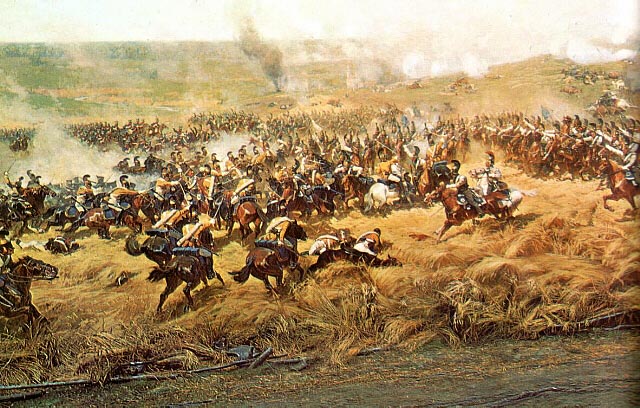
Wounding of Bagration
The picture by Vepskhadze
The fury and thirst for revenge captured the souls of soldiers that were near Bargation. When he was carried away, cuirassier Adrianov, who served him during battle (gave him a spy-glass and so on) ran to his stretcher and said:
"Sir, you are being taken away for treatment, so you no longer need me!" Then, witnesses said, "Adrianov flew like an arrow, ran into the enemy lines swiftly, and was killed only after he had killed many of the enemy".
As General Saint-Priest reported to Alexander afterwards, the capture of the "Bargation's arrows" and redoubts by the French was the result of the mortal wounding of Bagration - the disappearance of the Commander from the field of battle. When the French began the assault of Semenovskoe village, the Russian had only 50 guns, while the French had more than 100. But during the action more and more guns were brought to the French Marshals and to Bargation as well. The points attacked by the French changed hands many times. so quickly that the artillery of both sides had no time to find out the positions of the troops, and at times fired at their own men. Just before the death of Bagration and the last storm of hisarrows, this small part of the field was shelled by 400 French guns and 300 Russian guns. Then Napoleon moved these guns against Raevsky's battery in the center of the Russian position.
There was a legend that Bargation died after he had torn away the bandages on his wounds and had bled to death not far from the field of battle. In reality, he was carried to Simly village in the Vladimir gubernia province where gangrene set in. Bagration died there on September 12,1812.
Bagration had been mortally wounded and was gone from the army. The left wing of the Russian Army was broken.

A fragment of The Borodino Panorama
by Rubaud
(One of the most culmination fragments of the Panorama, "The Cavalry fighting in rye". A heated fighting between Saxon and Russian cuirassiers)
"Cavalry attack followed cavalry attack again and again. So massive and powerful that both sides suffered terrible losses, and the horses of killed cavalrymen ran in large, disordered herds" So wrote General Nikitin, a surviving participant of the Borodino battle.
After the capture of the "arrows", the next main battle was for the so-called "Barrow Battery" or Raevsky's battery,in the center of the Russian front. After the capture of Borodino village by the French, the Russian Jagers (Chasseurs) drove the enemy out, but then, in turn, the Jagers were dislodged from the village again.
Borodino village was finally French, and Vice-King of Italy, Eugene de Beauharnais, crossed the Kolocha River and attacked the "barrow battery". This central Russian battery was under constant attack by the French from 10 am on.
General Bonamy captured Raevsky's "barrow" battery by fierce assault, but was dislodged by the Russians. He attacked again and recaptured the battery again, only to be forced out a second time.
Russian General Ermolov hurled back the Division of Brussie from Raevsky's battery and the approaches to it. During the battle General Brussier was wounded by bayonet thrusts and taken prisoner. Napoleon ordered the battery recaptured by all possible means. At 2 p.m. He ordered the artillery to take the positions around the Bagration's flashes that were captured after the wounding of Bagration. The terrible artillery fire from there mowed down the Russian troops. The cannon-balls plowed the ground sweeping away people; horses; charge boxes; guns - everything.
Explosive grenades each killed scores of men, while the French artillery fired at Raevsky's battery and the retreating Russian troops, from the flashes and the right flank.
The Russian artillery replied with their own mortal fire, but the French fire was stronger. Napoleon's determination to capture Raevsky's battery at any cost became clear and afterwards he planned to finish his victorious artillery duel by disordering the Russian army with artillery fire and putting it to flight.
But that did not happen - the Russian army retreated in full order.
Ataman Platov with his Cossacks, and General Uvarov (Commander of the 1st Russian Cavalry), with cavalry under the order of Kutuzov, made a huge diversion almost in the rear of Napoleon's army. They crossed the Kolocha River and put to flight a French Cavalry brigade that had been standing rather far from the center of battle, not expecting an attack, and they attacked the infantry behind Napoleon. This attack was repulsed and the Russian suffered heavy losses, but it saved Raevsky's battery for several hours.
Uvarov was ordered to retreat, and Platov was thrown back. But although this raid of the Russian cavalry did not prevent the final destruction of the battery of Raevsky, it cost Napoleon the opportunity to completely satisfy the requests of Marshals Ney, Murat and Davout for reinforcements. Napoleon replied he could not risk his Guard when he was such a long distance from France, and he "has not seen the chess-board clearly enough yet".
One of the reasons for this refusal was, of course, his feeling that the rear was not protected safely after the French were surprising by this bold raid of Platov and Uvarov.